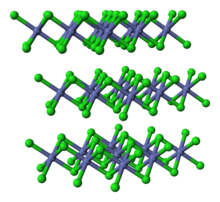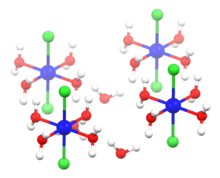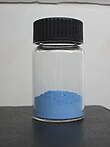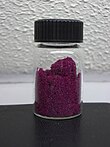Cobalt(II) chloride
| |||
 Structure of anhydrous compound
| |||
 Structure of hexahydrate
| |||
| Names | |||
|---|---|---|---|
| IUPAC name
Cobalt(II) chloride
| |||
| Other names | |||
| Identifiers | |||
| |||
3D model (
JSmol ) |
|||
| ChEBI | |||
| ChemSpider | |||
ECHA InfoCard
|
100.028.718 | ||
| EC Number |
| ||
PubChem CID
|
|||
RTECS number
|
| ||
| UNII |
| ||
| UN number | 3288 | ||
CompTox Dashboard (EPA)
|
|||
| |||
| |||
| Properties | |||
| CoCl2 | |||
| Molar mass | 129.839 g/mol (anhydrous) 165.87 g/mol (dihydrate) 237.93 g/mol (hexahydrate) | ||
| Appearance | blue crystals (anhydrous) violet-blue (dihydrate) rose red crystals (hexahydrate) | ||
| Density | 3.356 g/cm3 (anhydrous) 2.477 g/cm3 (dihydrate) 1.924 g/cm3 (hexahydrate) | ||
| Melting point | 726 °C (1,339 °F; 999 K) ±2 (anhydrous)[2] 140 °C (monohydrate) 100 °C (dihydrate) 86 °C (hexahydrate) | ||
| Boiling point | 1,049 °C (1,920 °F; 1,322 K) | ||
| 43.6 g/100 mL (0 °C) 45 g/100 mL (7 °C) 52.9 g/100 mL (20 °C) 105 g/100 mL (96 °C) | |||
| Solubility | 38.5 g/100 mL (methanol) 8.6 g/100 mL (acetone) soluble in ethanol, pyridine, glycerol | ||
| +12,660·10−6 cm3/mol | |||
| Structure | |||
| CdCl2 structure | |||
| hexagonal (anhydrous) monoclinic (dihydrate) Octahedral (hexahydrate) | |||
| Hazards | |||
| GHS labelling: | |||
  
| |||
| NFPA 704 (fire diamond) | |||
| Flash point | Non-flammable | ||
| Lethal dose or concentration (LD, LC): | |||
LD50 (median dose)
|
80 mg/kg (rat, oral) | ||
| Safety data sheet (SDS) | ICSC 0783 | ||
| Related compounds | |||
Other anions
|
Cobalt(II) fluoride Cobalt(II) bromide Cobalt(II) iodide | ||
Other cations
|
Rhodium(III) chloride Iridium(III) chloride | ||
Except where otherwise noted, data are given for materials in their standard state (at 25 °C [77 °F], 100 kPa).
| |||
Cobalt(II) chloride is an inorganic compound, a salt of cobalt and chlorine, with the formula CoCl
2. The compound forms several hydrates CoCl
2·nH
2O, for n = 1, 2, 6, and 9. Claims of the formation of tri- and tetrahydrates have not been confirmed.[4] The anhydrous form is a blue crystalline solid; the dihydrate is purple and the hexahydrate is pink. Commercial samples are usually the hexahydrate, which is one of the most commonly used cobalt salts in the lab.[5]
Properties
Anhydrous
At room temperature, anhydrous cobalt chloride has the
Solutions
Cobalt chloride is fairly
2 in water is about 54% at the boiling point, 120.2 °C; 48% at 51.25 °C; 35% at 25 °C; 33% at 0 °C; and 29% at −27.8 °C.[4]
Diluted
2 contain the species [Co(H
2O)
6]2+
, besides chloride ions. Concentrated solutions are red at room temperature but become blue at higher temperatures.[7]
Hydrates

The crystal unit of the solid hexahydrate CoCl
2•6H
2O contains the neutral molecule trans-CoCl
2(H
2O)
4 and two molecules of water of crystallization.[8] This species dissolves readily in water and alcohol.
The anhydrous salt is
Preparation
Cobalt chloride can be prepared in aqueous solution from cobalt(II) hydroxide or cobalt(II) carbonate and hydrochloric acid:
- CoCO
3 + 2 HCl(aq) → CoCl
2(aq) + CO
2 + H
2O
- Co(OH)
2 + 2 HCl(aq) → CoCl
2(aq) + 2H
2O
The solid dihydrate and hexahydrate can be obtained by evaporation. Cooling saturated aqueous solutions yields the dihydrate between 120.2 °C and 51.25 °C, and the hexahydrate below 51.25 °C. Water ice, rather than cobalt chloride, will crystallize from solutions with concentration below 29%. The monohydrate and the anhydrous forms can be obtained by cooling solutions only under high pressure, above 206 °C and 335 °C, respectively.[4]
The anhydrous compound can be prepared by heating the hydrates.[10]
On rapid heating or in a closed container, each of the 6-, 2-, and 1- hydrates partially melts into a mixture of the next lower hydrate and a saturated solution—at 51.25 °C, 206 °C, and 335 °C, respectively.[4] On slow heating in an open container, so that the water vapor pressure over the solid is practically zero, water evaporates out of each of the solid 6-, 2-, and 1- hydrates, leaving the next lower hydrate, at about 40°C, 89°C, and 125°C, respectively. If the partial pressure of the water vapor is in equilibrium with the solid, as in a confined but not pressurized contained, the decomposition occurs at about 115°C, 145°C, and 195°C, respectively.[4]
Dehydration can also be effected with trimethylsilyl chloride:[11]
- CoCl
2•6H
2O + 12 (CH
3)
3SiCl → CoCl
2 + 6[(CH
3)
3SiCl]
2O + 12 HCl
The anhydrous compound can be purified by sublimation in vacuum.[2]
Reactions
In the laboratory, cobalt(II) chloride serves as a common precursor to other cobalt compounds. Generally, diluted aqueous solutions of the salt behave like other cobalt(II) salts since these solutions consist of the [Co(H
2O)
6]2+
ion regardless of the anion. For example, such solutions give a precipitate of cobalt sulfide CoS upon treatment with hydrogen sulfide H
2S.[citation needed]
Complexed chlorides
The hexahydrate and the anhydrous salt are weak
5H
5N):[12]
- CoCl
2·6H
2O + 4 C
5H
5N → CoCl
2(C
5H
5N)
4 + 6 H
2O
With triphenylphosphine (P(C
6H
5)
3), a tetrahedral complex results:
- CoCl
2·6H
2O + 2 P(C
6H
5)
3 → CoCl
2[P(C
6H
5)
3]
2 + 6 H
2O
Salts of the anionic complex CoCl42− can be prepared using tetraethylammonium chloride:[13]
- CoCl
2 + 2 [(C2H5)4N]Cl → [(C2H5)4N)]2[CoCl4]
The tetrachlorocobaltate ion [CoCl4]2− is the blue ion that forms upon addition of hydrochloric acid to aqueous solutions of hydrated cobalt chloride, which are pink.
Reduction
Reaction of the anhydrous compound with
5H
5)
2]+
.
Oxidation to cobalt(III)
Compounds of cobalt in the +3 oxidation state exist, such as cobalt(III) fluoride CoF
3, nitrate Co(NO
3)
3, and sulfate Co
2(SO
4)
3; however, cobalt(III) chloride CoCl
3 is not stable in normal conditions, and would decompose immediately into CoCl
2 and chlorine.[14]
On the other hand, cobalt(III) chlorides can be obtained if the cobalt is bound also to other ligands of greater Lewis basicity than chloride, such as
- 4 CoCl
2·6H
2O + 4 NH
4Cl + 20 NH
3 + O
2 → 4 [Co(NH
3)
6]Cl
3 + 26 H
2O
Similar reactions occur with other amines. These reactions are often performed in the presence of charcoal as a catalyst, or with hydrogen peroxide H
2O
2 substituted for atmospheric oxygen. Other highly basic ligands, including carbonate, acetylacetonate, and oxalate, induce the formation of Co(III) derivatives. Simple carboxylates and halides do not.[citation needed]
Unlike Co(II)
Oxidation to cobalt(IV)
Reaction of 1-norbornyllithium with the CoCl
2·THF in pentane produces the brown, thermally stable tetrakis(1-norbornyl)cobalt(IV)[15][16] — a rare example of a stable transition metal/saturated alkane compound,[5] different products are obtained in other solvents.[17]
Moisture indication

Cobalt chloride is a common visual moisture indicator due to its distinct colour change when hydrated. The colour change is from some shade of blue when dry, to a pink when hydrated, although the shade of colour depends on the substrate and concentration. It is impregnated into paper to make test strips for detecting moisture in solutions, or more slowly, in air/gas. Desiccants such as silica gel can incorporate cobalt chloride to indicate when it is "spent" (i.e. hydrated).[18]
Health issues
Cobalt is essential for most higher forms of life, but more than a few milligrams each day is harmful. Although poisonings have rarely resulted from cobalt compounds, their chronic ingestion has caused serious health problems at doses far less than the lethal dose. In 1966, the addition of cobalt compounds to stabilize
Furthermore, cobalt(II) chloride is suspected of causing
In 2005–06, cobalt chloride was the eighth-most-prevalent allergen in patch tests (8.4%).[23]
Other uses
- Invisible ink: when suspended in solution, cobalt(II) chloride can be made to appear invisible on a surface; when that same surface is subsequently exposed to significant heat (such as from a handheld heat gun or lighter) the ink reversibly changes to blue.[24]
- Cobalt chloride is an established chemical inducer of hypoxia-like responses such as erythropoiesis.[citation needed] Cobalt supplementation is not banned and therefore would not be detected by current anti-doping testing.[25] Cobalt chloride is a banned substance under the Australian Thoroughbred Racing Board.[26]
- Cobalt chloride is one method used to induce pulmonary arterial hypertension in animals for research and evaluation of treatment efficacy.
References
- ^ "Cobalt muriate, CAS Number: 7646-79-9". www.chemindustry.com. Archived from the original on 28 May 2019. Retrieved 19 April 2018.
- ^ .
- ^ Santa Cruz Biotechnology: Cobalt(II) chloride
- ^ Note: the lowest point of fig.6 is inconsistent with fig.7; probably should be at -27.8 C instead of 0 C.
- ^ ISBN 978-0-08-037941-8.
- ^ The Merck Index, 7th edition, Merck & Co, Rahway, New Jersey, USA, 1960.
- ISBN 0-19-855370-6
- .
- ISBN 9780470132609.
- .
- ISBN 9780470132401.
- ^ Handbook of Chemistry and Physics, 71st edition, CRC Press, Ann Arbor, Michigan, 1990.
- .
- .
- .
- ISSN 0003-4746.
- S2CID 7422045.
- PMID 10382556.
- ^ 11.1.5 The unusual type of myocardiopathy recognized in 1965 and 1966 in Quebec (Canada), Minneapolis (Minnesota), Leuven (Belgium), and Omaha (Nebraska) was associated with episodes of acute heart failure (e/g/, 50 deaths among 112 beer drinkers).
- ^ Zug KA, Warshaw EM, Fowler JF Jr, Maibach HI, Belsito DL, Pratt MD, Sasseville D, Storrs FJ, Taylor JS, Mathias CG, Deleo VA, Rietschel RL, Marks J. Patch-test results of the North American Contact Dermatitis Group 2005–2006. Dermatitis. 2009 May–Jun;20(3):149-60.
- ^ "Making invisible ink". Royal Society of Chemistry. Retrieved 7 April 2023.
- PMID 16244201.
- ^ Bartley, Patrick (6 February 2015). "Cobalt crisis turns the eyes of the world onto Australian racing". The Sydney Morning Herald.



